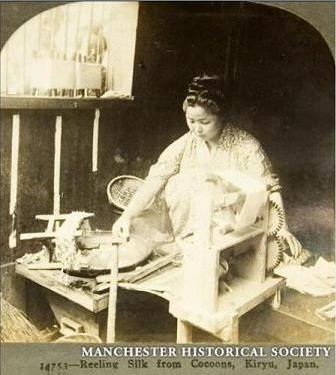



The single fiber as it leaves the cocoon is almost infinitesimal; it is not wound singly on the reel. From eight to fifteen threads from as many cocoons are combined in a single thread for the reel. This is done, where modern appliances have been introduced, by passing the numerous fibers through perforated agates a few inches above the vessel that contains the cocoons, and thence upward over the guide-eyes to the reel. The traverse moves horizontally from side to side, distributing the thread over the reel in a broad skein. The natural gum of the silk sticks the threads together--both the dozen or more cocoon fibers that constitute a thread, and also the threads that make a skein.
The fine thread from the cocoon is slightly thicker in the more compact part, but it diminishes again toward the center of the ball, and finally becomes too slight to endure the strain of reeling. The explanation of this weakness is that one of the worm's silk glands became exhausted before the other and the cocoon was finished with one-half supply.
If a thread breaks or a cocoon runs empty, the reeler takes up the thread or takes a fresh cocoon, and unites it with the running thread by a deft movement of the fingers.

 )
)